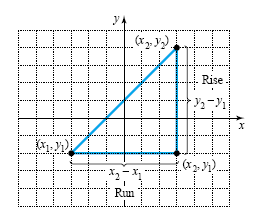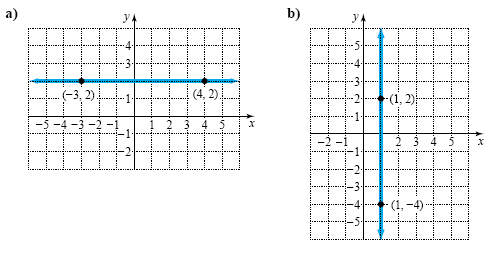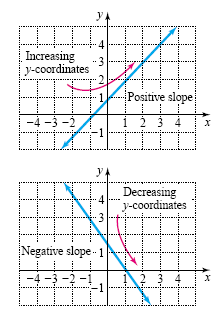|
Using Coordinates to Find SlopeWe can obtain the rise and run from a graph, or we can get them without a graph by subtracting the y-coordinates to get the rise and the x-coordinates to get the run for two points on the line. See the figure below.
Slope Using Coordinates The slope m of the line containing the points (x1, y1) and (x2, y2) is given by
Example 1 Finding slope from coordinates Find the slope of each line. a) The line through (2, 5) and (6, 3) b) The line through (-2, 3) and (-5, -1) c) The line through (-6, 4) and the origin Solution a) Let (x1, y1) = (2, 5) and (x2, y2) = (6, 3). The assignment of (x1, y1) and (x2, y2) is arbitrary.
b) Let (x1, y1) = (-5, -1) and (x2, y2) = (-2, 3):
c) Let (x1, y1) = (0, 0) and (x2, y2) = (-6, 4):
Caution Do not reverse the order of subtraction from numerator to denominator when finding the slope. If you divide y2 - y1 by x1 - x2, you will get the wrong sign for the slope. Example 3 Slope for horizontal and vertical lines Find the slope of each line.
Solution a) Using (-3, 2) and (4, 2) to find the slope of the horizontal line, we get
b) Using (1, -4) and (1, 2) to find the slope of the vertical line, we get x2 - x1 = 0. Because the definition of slope using coordinates says that x2 - x1 must be nonzero, the slope is undefined for this line.
Helpful Hint Think about what slope means to skiers. No one skis on cliffs or even refers to them as slopes.
Since the y-coordinates are equal for any two points on a horizontal line, y2 - y1 = 0 and the slope is 0. Since the x-coordinates are equal for any two points on a vertical line, x2 - x1 = 0 and the slope is undefined. Horizontal and Vertical Lines The slope of any horizontal line is 0. Slope is undefined for any vertical line.
Caution Do not say that a vertical line has no slope because “no slope†could be confused with 0 slope, the slope of a horizontal line. As you move the tip of your pencil from left to right along a line with positive slope, the y-coordinates are increasing. As you move the tip of your pencil from left to right along a line with negative slope, the y-coordinates are decreasing. See the following figure.
|
|






